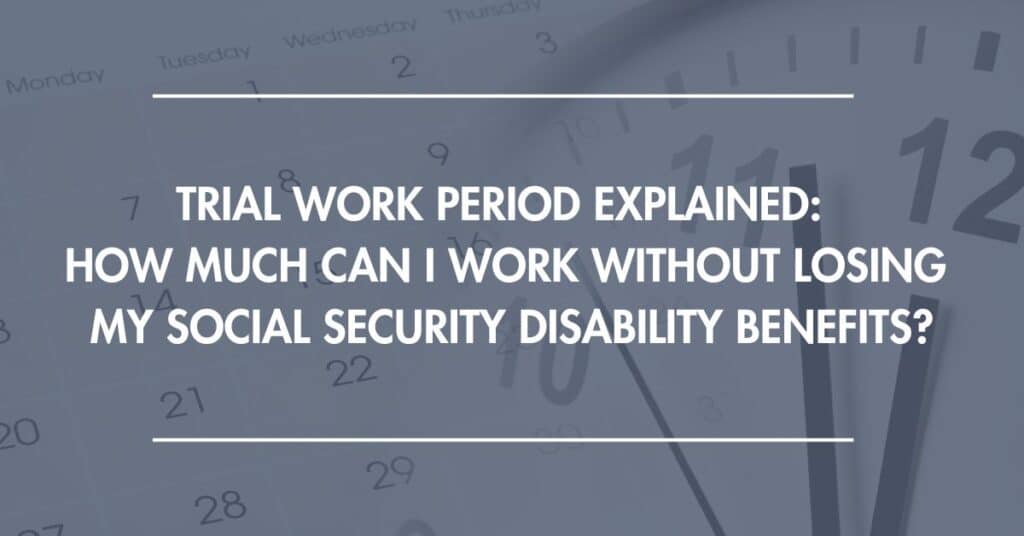
Receiving Social Security Disability Insurance (SSDI) benefits doesn’t necessarily mean you can never work again. The Social Security Administration (SSA) recognizes that many people with disabilities may want to try and return to the workforce, or gradually return to a level of gainful employment. To support this transition, the SSA established work incentive programs and a “trial work period.” If you are currently receiving SSDI benefits and are contemplating returning to work, it is important to have a general understanding of the trial work period and what rules apply to ensure your benefits are not adversely impacted.
Understanding SSDI and Work Capacity
By way of background, the Social Security Disability Insurance program provides monthly cash benefits to individuals who have worked and paid Social Security taxes but can no longer work due to a severe medical condition expected to last at least one year or result in death. However, the SSA understands that medical conditions can improve, treatments can become more effective, and people may develop new coping strategies that allow them to work despite their disabilities.
The challenge lies in balancing the need to provide security for those who cannot work while encouraging those who might be able to return to employment. This is where work incentive programs become crucial, offering a safety net that allows beneficiaries to test their work capacity without immediately losing their benefits.
Overview of the Trial Work Period
The trial work period is a work incentive program that allows SSDI beneficiaries to test their ability to maintain employment for at least nine months without losing their disability benefits, regardless of how much they earn during those months. This period provides a crucial buffer that allows individuals to explore their work capacity while maintaining the financial security of their SSDI benefits.
During the trial work period, individuals continue to receive their full SSDI monthly payments regardless of their earnings, as long as they report their work activity to the SSA and continue to have a disabling impairment. For example, if someone earns $3,000 or $4,000 per month during the trial work period, they will still receive their full SSDI benefit amount.
However, it is important to understand that the trial work period is finite and typically only lasts for nine months within a 60-month (five-year) rolling period. It is worth noting that the nine months do not need to be consecutive, which provides an additional level of flexibility for individuals whose work capacity may fluctuate due to their medical conditions. For example, someone might work for three months, take a break due to health issues, then work for another four months, and later work for two more months – all within the five-year window.
A month counts as a trial work month if the beneficiary’s gross earnings exceed a specific threshold amount or if they work more than 80 hours in self-employment. For 2025, this threshold is $1,160 per month.
The trial work period only applies to SSDI beneficiaries and is not applicable to recipients of Supplemental Security Income (SSI). In fact, SSI has different work rules and incentives since it is a need-based program rather than an insurance program based on work history.
Understanding the Extended Period of Eligibility
After completing the 9-month trial work period, SSDI beneficiaries enter what’s called the Extended Period of Eligibility (EPE), which lasts for approximately 36 consecutive months. During this period, beneficiaries can receive SSDI payments for any month their earnings fall below the Substantial Gainful Activity (SGA) threshold.
For 2025, the SGA threshold is $1,620 per month for non-blind individuals and $2,700 for blind individuals. If earnings exceed these amounts, the beneficiary won’t receive SSDI payments for that month, but if earnings drop below the threshold in subsequent months, payments can resume without needing to file a new application.
This creates a safety net that acknowledges the reality that many people with disabilities may have fluctuating work capacity. Someone might be able to work full-time for several months but then need to reduce hours or stop working temporarily due to their medical condition.
Reporting Obligations
SSDI recipients are obligated to report their work activity to the SSA, including when they start or stop working, changes in earnings, and any changes in their medical condition. This reporting requirement is crucial for maintaining benefits and avoiding overpayments that might need to be repaid later.
The SSA provides several ways to report work activity, including online through the my Social Security portal, by phone, or by visiting a local Social Security office. Beneficiaries should keep detailed records of their work activity, including pay stubs, work schedules, and any accommodations provided by employers.
Expedited Reinstatement
Even after the EPE concludes, SSDI beneficiaries have additional protections through the Expedited Reinstatement (EXR) provision. For context, EXR comes into play if someone loses their SSDI benefits due to work activity but then becomes unable to work again within five years, they can request expedited reinstatement of benefits without going through the lengthy initial application process.
During the EXR process, individuals may be eligible for provisional benefits for up to six months while the SSA determines whether their condition has worsened enough to qualify for benefits again.
For anyone considering work while receiving SSDI benefits, the key is to understand the rules, maintain good communication with the SSA, and seek professional guidance when needed. With proper planning and support, many SSDI beneficiaries can successfully resume some level of work activities and potentially transition to greater self-sufficiency while maintaining financial support through SSDI benefits.
Have Questions? Speak to an Experienced SSDI Lawyer Today
Working while receiving SSDI benefits requires careful planning to ensure you do not violate relevant work rules and regulations and potentially jeopardize your benefits. If you are working and were notified about issues with your SSDI benefits, or you are applying for SSDI benefits, consider contacting an experienced and knowledgeable SSDI lawyer with Bross & Frankel. Our legal team is ready and able to assist you in compiling the necessary paperwork for your benefits application and to address any concerns related to the interplay between SSDI benefits and the trial work period. To learn more or to schedule a free claim review, contact Bross & Frankel today.

Rich Frankel is the managing partner of Bross & Frankel. He is a member of the New Jersey and Pennsylvania bars. He has focused exclusively on disability and social security benefits since 2005.
Mr. Frankel joined what is now Bross & Frankel after having watched his father struggle with disability, fighting a lengthy illness. Mr. Frankel founded the firm’s veteran’s law practice and substantially grew the social security disability practice, focusing Bross & Frankel’s ability to fight for all of the disability benefits available to his clients.
Mr. Frankel additionally fights for clients in court, obtaining frequent victories in Social Security appeals and against insurance companies in Federal court.